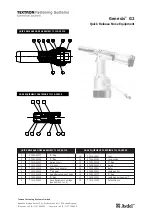
Page 7
For technical questions, please call 1-888-866-5797.
Item 64518
Sa
FE
ty
Op
Era
ti
O
n
Maint
Enanc
E
SE
tup
initial tool Set up/assembly
read the EntirE iMpOrtant SaFEty inFOrMatiOn section at the beginning of this
manual including all text under subheadings therein before set up or use of this product.
note:
For additional information regarding the parts listed in the following pages,
refer to the Assembly Diagram near the end of this manual.
note:
This air tool may be shipped with a protective plug covering the air inlet. Remove this plug before set up.
air Supply
tO prEVEnt SEriOuS inJury FrOM EXpLOSiOn:
use only clean, dry, regulated, compressed air to power this tool.
Do not use oxygen, carbon dioxide, combustible gases,
or any other bottled gas as a power source for this tool.
1. Incorporate a filter, regulator with pressure gauge,
oiler, in-line shutoff valve, and quick coupler for
best service, as shown on Figure A on page 8
and Figure B on page 9.
an in-line shutoff
ball valve is an important safety device because
it controls the air supply even if the air hose
is ruptured. the shutoff valve should be a
ball valve because it can be closed quickly.
note:
If an automatic oiler system is not used,
add a few drops of Pneumatic Tool Oil to the airline
connection before operation. Add a few more drops
after each hour of continual use.
2. Attach an air hose to the compressor's air outlet.
Connect the air hose to the air inlet of the tool.
Other components, such as a coupler plug
and quick coupler, will make operation
more efficient, but are not required.
WarninG! tO prEVEnt SEriOuS inJury
FrOM acciDEntaL OpEratiOn:
Do not install a female quick coupler on the tool.
Such a coupler contains an air valve that will
allow the air tool to retain pressure and operate
accidentally after the air supply is disconnected.
note:
Air flow, and therefore tool performance,
can be hindered by undersized air supply components.
The air hose must be long enough to reach
the work area with enough extra length to
allow free movement while working.
3. Turn the tool's throttle or switch to the off position;
refer to Operation section for description of controls.
4. Close the in-line shutoff valve between
the compressor and the tool.
5. Turn on the air compressor according to
the manufacturer's directions and allow it
to build up pressure until it cycles off.
6. Adjust the air compressor's output regulator
so that the air output is enough to properly
power the tool, but the output will not exceed
the tool's maximum air pressure at any time.
Adjust the pressure gradually, while checking the
air output gauge to set the right pressure range.
7. Inspect the air connections for leaks.
Repair any leaks found.
8. If the tool will not be used at this time, turn off
and detach the air supply, safely discharge
any residual air pressure, and release
the throttle and/or turn the switch to its off
position to prevent accidental operation.
9. Residual air pressure should not be present
after the tool is disconnected from the air
supply. However, it is a good safety measure
to attempt to discharge the tool in a safe
fashion after disconnecting to ensure that the
tool is disconnected and not powered.


































